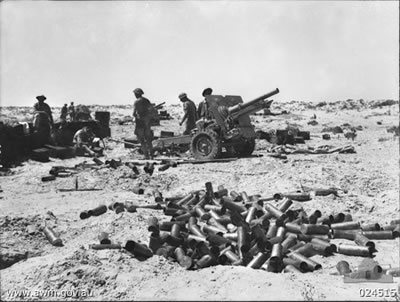
Last updated on February 17th, 2019 at 09:46 pm
A British attempt to prevent Axis forces in North Africa from advancing to Alexandria, Egypt led to the First Battle of El Alamein during World War II.
During the First Battle of El Alamein, the British tank force clearly had a numerical advantage over German armored forces. However, the British were hampered by poor strategy and communications.
British forces in North Africa were in chaos after Tobruk fell to Rommel’s forces in June 1942. Rommel took advantage of this by harrying the British as they were retreating to the Egyptian border.
 However, the British rear guard was able to slow down the Axis advance enough so that a defense and counterstrike could be prepared.
However, the British rear guard was able to slow down the Axis advance enough so that a defense and counterstrike could be prepared.
Auchinleck began coordinating a defense at the Egyptian town of El Alamein, where British troops were protected by the Qattara Depression to the south and by the sea to the north. There were also three small ridges at El Alamein that emplaced troops could use for defense.
A railway, which provided a supply line, ran 2 miles (3.2 kilometers) south of the sea.
The British continued to use brigade boxes for their defense.
Because of the British position, Rommel was forced to attack from the front.
On June 30, the Afrika Korps’ panzer divisions feinted to the south in order to draw away British armored forces.
The next day, July 1, Axis forces attacked.
Rommel planned to move his armored forces and motorized infantry between the brigade boxes, attacking the rear whenever they could.
Things did not work out as planned.
The Axis attack was delayed because of sandstorms and attacks by the RAF.
Soft desert sand slowed down the German 90th Light Infantry Division.
Because there were no landmarks to rely on, the German infantry got lost. Instead of moving between the British defenses, the infantry ran right into them and the British stopped them.
The panzers, on the other hand, were able to overrun the 18th Indian Infantry Brigade, which had a few Matilda tanks. The panzer force, which had no ammunition, relied on its full strength of about 55 tanks. By the time the panzers were able to break through, they had lost about two fifths of the tanks.
The British had communication problems, which caused a delay in the launch of an armored counterattack that was supposed to relieve the Indian brigade.
Despite all of the difficulties that the British encountered, Rommel was not able to continue his breakthrough. The Afrika Korps had itself experienced many delays and had lost too many tanks to go on as planned.
Auchinleck decided to use British tanks to attack the Italian infantry so that the German panzers would have to react. He knew that the Germans had lost many of their tanks and had only a small number left.
In fact, the Germans had only about 26 tanks, some of which were old Panzer IIs.
On the other hand, the British 1st Armoured Division had more than 100 tanks, including 38 Grants.
Auchinleck though that the panzers would become overworked and either run out of fuel or break down.
On July 3, as Axis infantry attacked El Alamein, the 1st Armored Division attacked and overran the Italian Ariete armored division. The Italian tanks were taken out of battle. The British captured all of the Italian artillery.
The British planned to continue on, attacking the Axis flanks and the Axis communication lines.
However, the Germans were able to intercept the British radio communications and Rommel learned the details of the British plan.
Fighting continued for several days.
The British received more tanks as reinforcements, so that they had more than 200 tanks available.
Auchinleck then pulled some of his infantry back, so the British would think that the British were withdrawing.
Rommel then turned his panzers northward to exploit the perceived withdrawal.
Auchinleck then attacked from the south.
On July 11, the 15th Panzer Division initiated a counterattack, preventing a British attack from the north from breaking through Axis forces.
However, the panzers were able to prevent the attack, but this only served to wear them down further.
At midnight on July 15, the British attacked again, but poor communications caused infantry and armored forces to become separate. German armor attacked the British infantry, who had no tanks to support them.
On July 16, the panzer force attacked again, but they were defeated and lost still more tanks.
The British on the other hand, had many tanks available to them. The 1st Armored Division still had more than 170 tanks. The 23rd Armored Brigade, which had just arrived, had 104 tanks, of which approximately 23 were Valentines.
Auchinleck launched another attack.
Although the British armored force had a numerical advantage, it suffered from disadvantages as well.
The Valentines’ radio equipment had not been adapted to local conditions, leading to more communication problems.
There were also strategic problems. Britain’s Eighth Army Headquarters decided that tanks could not be moved at night.
The Germans, meanwhile, prepared for a counterattack by moving their tanks into position overnight. They attacked British infantry while British tanks were out of position.
The British tanks had to rush into position to help defend the infantry from the German tank force.
They ran into minefields that were covered with antitank guns.
The 23rd Armored Brigade lost 93 tanks.
The British infantry attempted another assault on the night between July 24 and July 25. A few German tanks were able to break up the infantry, which had no armored support.
Effectively, the First Battle of El Alamein ended in a stalemate.
In August 1942, Auchinleck was replaced by Lieutenant-General Bernard Montgomery.
